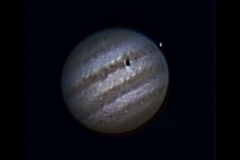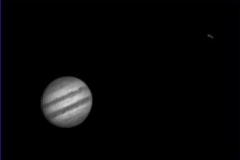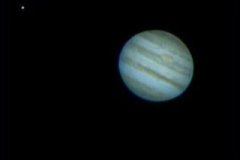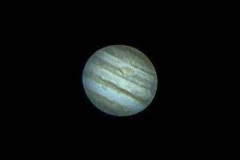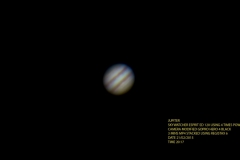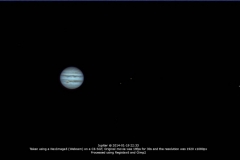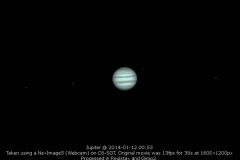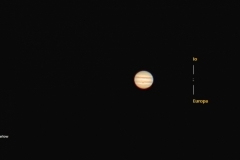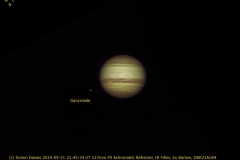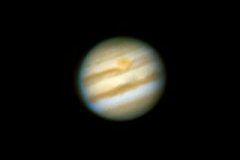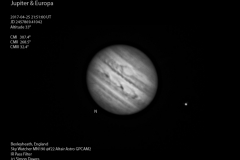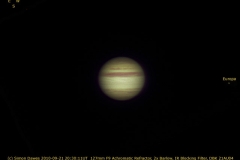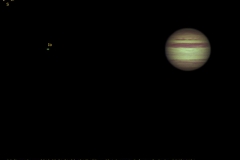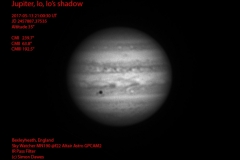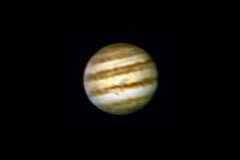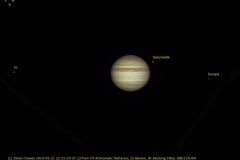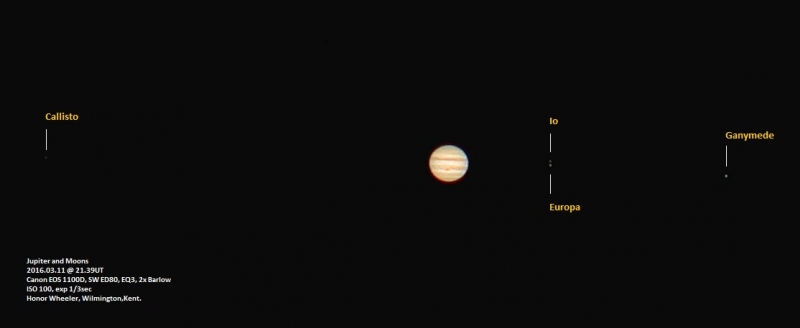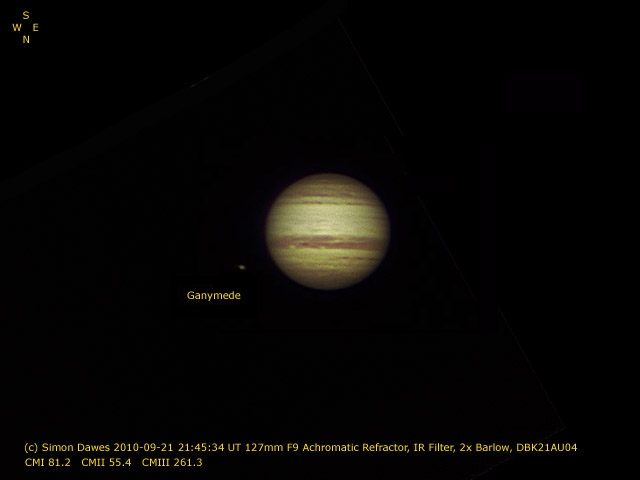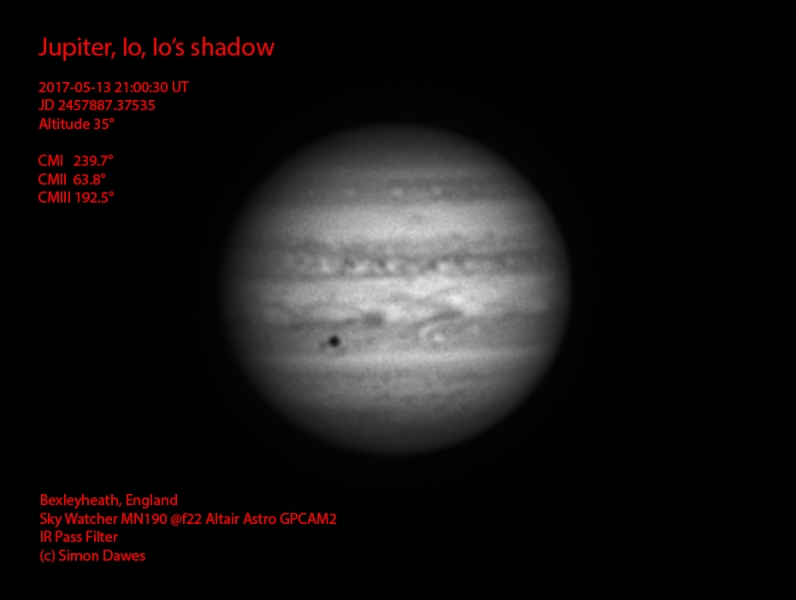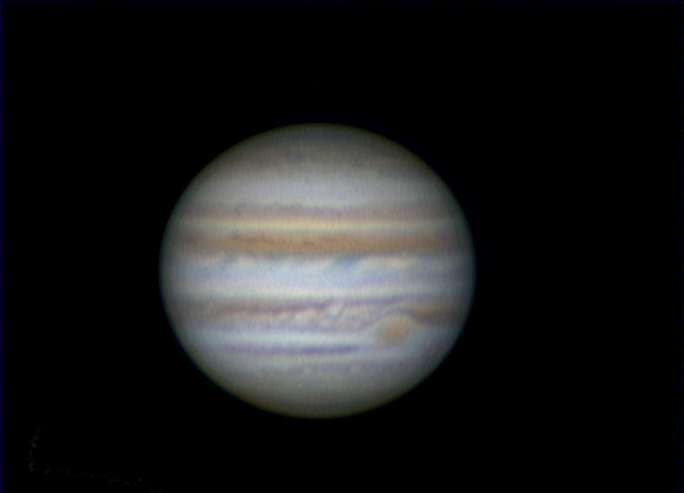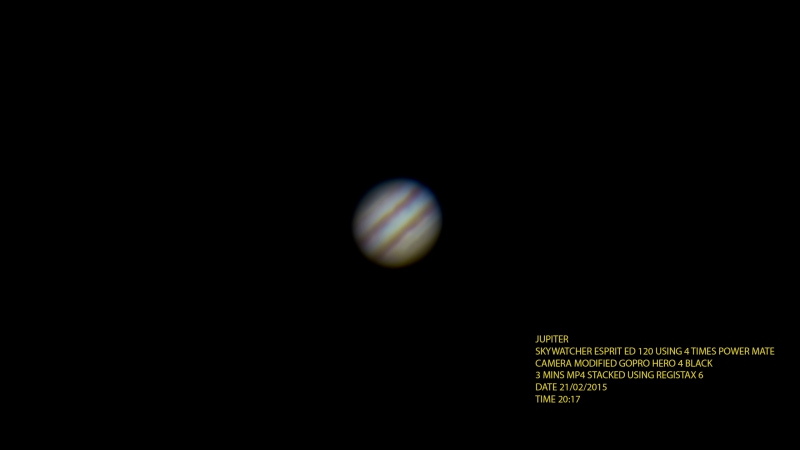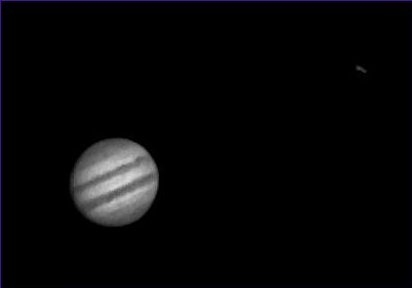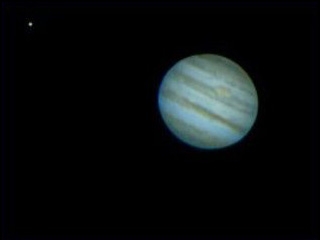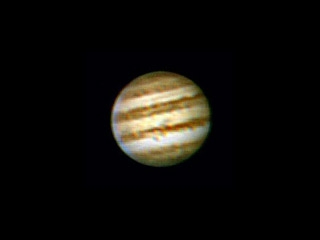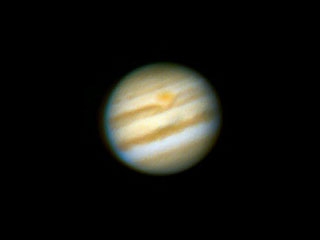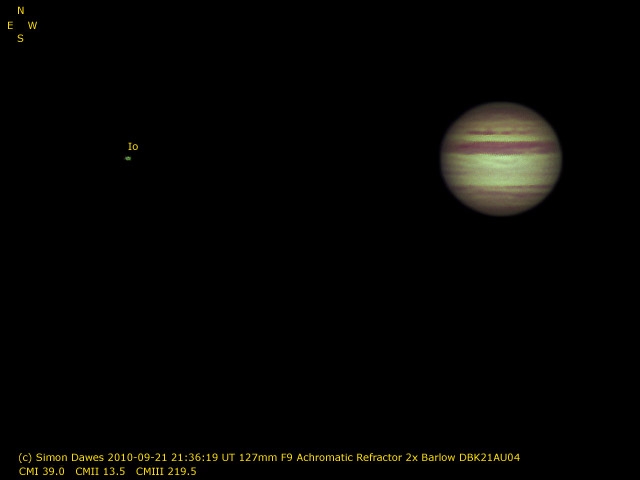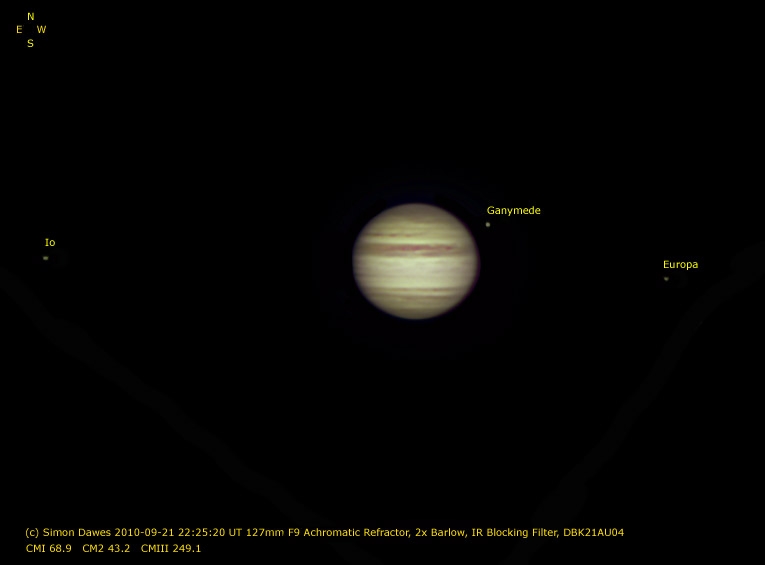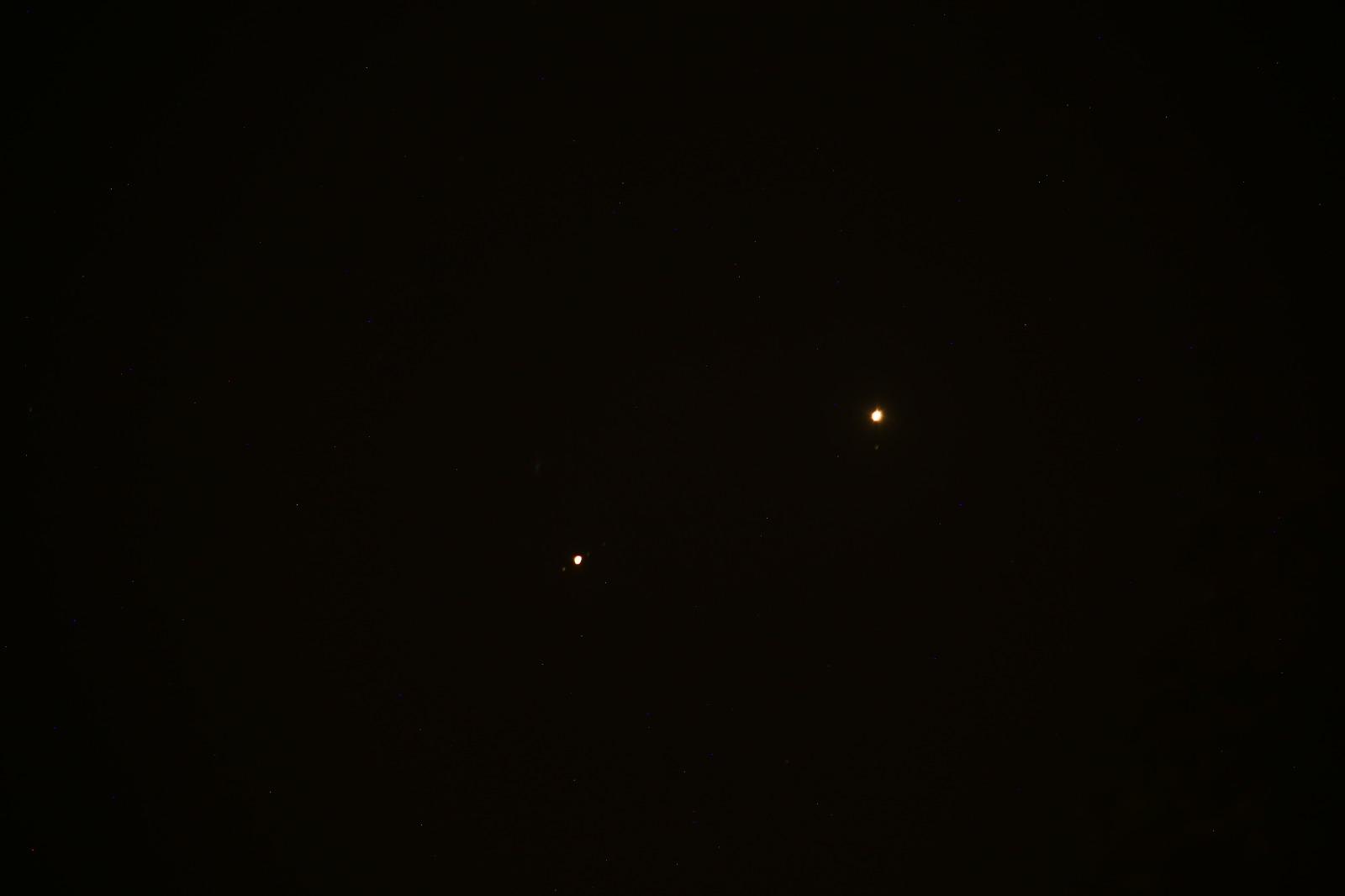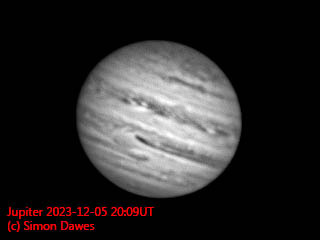Jupiter is the largest planet in the Solar System and a great observing target, look out for the Great Red Spot, the four Gallean moons, transits of the moons and their shadows across the surface of Jupiter.
Wikipedia entry for Jupiter | BAA Jupiter Section
Observing Jupiter
Almost any telescope or binoculas will allow you to see that Jupiter is a disk, and see the 4 main moons orbiting around the planet, and only modest telescopes are needed to see the bands and zones and some of the changing features on the surface and transits of shaddows and moons across the disk.
Recommended Filters.
You can improve the contrast of some features on Jupiter with the use of filters, however some will block a lot of light so may require a larger telescope.
Wratten #8 (Light Yellow) Improves contrast of the belts and zones.
Wratten #21 (Orange) Improves contrast around the edges of the equitorial belts
Wratten 25A (Red) Improves festoons (bluish clouds) on Jupiter
Wratten 38A (Dark Blue) Improves the Great Red Spot and main equitorial belts
Wratten 58 (Green) Improves polar regions
Imaging Filters
IR Pass Useful if imaging with a CCD or webcam to steady the seeing and increase contrast.
Jupiter using a red filter – 5th Dec 2023
A great image of Jupiter taken by member and trustee Simon Dawes.
The image was taken on the 5th Dec 2023 using a Celestron EDGE11HD, with a red filter, f2800mm (f10), Rising Cam CMOS sensor and Mesu e200 mount. Sharpcap Pro, 2 min of video, stacked in AutoStakkert, processed in Registax 6 and Photoshop.

For more member images of Jupiter check out the Jupiter section on our website.
For more information about using filters for visual observing of the Moon and planets https://britastro.org/2018/filters-for-visual-observing-of-the-moon-and-planets
Moon & Jupiter by Diane Clarke
A lovely image of the Moon and Jupiter taken by member Diane Clarke.
Diane wrote ” Jupiter & the Moon 4° apart. I went to image this event as it rose above my local horizon, but the sky was cloudy so I decided to wait as both Jupiter & the Moon would need to clear a local stand of trees. Fortunately, after they cleared the trees the sky broke giving me the opportunity to take an image of the event.
Image taken: 01.10.23 @22.33 hrs BST. Camera: Canon EOS M50m2. Lens: Canon EF L 100 – 400mm @ 160mm, F-stop f/5.6 @ 1/320 sec and ISO 800.”

Crescent Moon & Jupiter by Jim Burchell
A great image of the crescent Moon (with Earthshine) and Jupiter taken on the 14th June 2023 with a Pentax KP 300mm by member Jim Burchell.
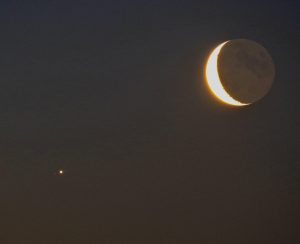
Images by Jim Burchell – 23rd to 25th Feb 2023
Member Jim Burchell was busy out and about towards the end of February photographing our stunning sky and below is a selection of his superb images.
Orion, Taurus and the Pleiades taken on the 23rd Feb from the CMHASD pavilion, Sutton-at-Hone.
Image was taken with a Pentax KP on a static tripod, F6.3, 30 sec, 18 MM and iso 800.

Crescent Moon on the 24th Feb.
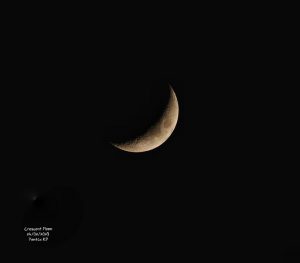
The Sun taken on the 24th Feb.
NEVER LOOK AT THE SUN DIRECTLY. Please see our Solar Observing safety page at crayfordmanorastro.com/solar-safety/

Crescent Moon with Jupiter & Venus on the 25th Feb.
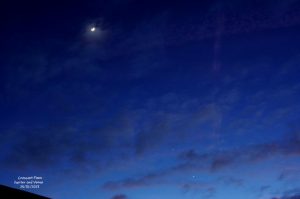
Jupiter & Venus – 22nd Jan 2023 by Jim Burchell
Two lovely photos taken by member Jim Burchell of the planets Jupiter & Venus on Sunday evening the 22nd Jan 2023. The photos were taken with a Pentax K70.
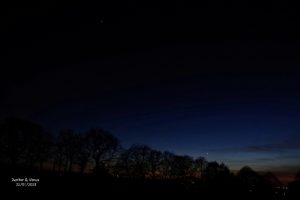
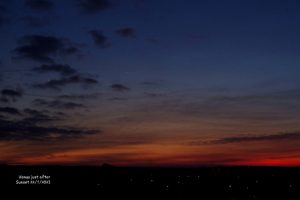
The Moon & Jupiter – 8th October 2022
The Moon & Jupiter on the 8th October 2022 taken by member Jim Burchell using a Pentax KP camera.
Jupiter is top left of the Moon in the photo.

Jupiter & Venus Conjunction 2022 by Richard Bohner
Whilst CMHASD member views of Venus & Jupiter from the UK were blocked by cloud, two superb images of Venus & Jupiter were captured in the early morning skies of the 28th & 30th April 2022 by member Richard Bohner in Arizona, USA.
The first image taken on the 28th at 04:30 MST was acquired using a Canon 6D, ISO 500 and an 8 second exposure time. Jupiter is on the left and Venus on the right and only 2.3 degrees apart.
The second image, taken on the 30th at 05:00 MST (using a Canon 6D, ISO 500 and a 6 second exposure time) shows Venus & Jupiter appearing even closer together, in fact very close. The planets were separated by the same angular distance as a full moon: about 1/2 degree!!! Three moons of Jupiter; Ganymede, Io and Callisto can also be seen in the 2nd image.
The Venus-Jupiter conjunction happens about once a year but this year the two planets appeared closer than they usually do. The last time the two planets were closer than this year’s conjunction was in August 2016 but it was more difficult to see since they were closer to the sun. The next time they will get this close is in 2039.
Jupiter & Venus 28th April 2022

Jupiter & Venus 30th April 2022

Although Venus and Jupiter appear next to each other in the sky they are nowhere near each other in space. The actual orbit of the planets is around 430 million miles apart (690 million km) nearly five times the Earth–sun distance!
You can also understand why the ancients called planets wanderers too.
Images of Jupiter by Martin Crow
Images of Jupiter by Julian Tworek
Jupiter Images by Gordon Collins
Jupiter Images by Andy Barber
Jupiter Images by Andy Smith
Jupiter Images by Honor Wheeler
Jupiter Images by Simon Dawes
Jupiter Gallery
Members images of the planet Jupiter.
Other Images
Sun | Comets | Mercury | Venus | Atmospheric Optics | Meteors | Auroa and NLC | Moon | Minor Planets | Mars | Jupiter | Saturn | Uranus | Neptune | Messier | Caldwell | All Deep Sky | Conjunctions | Transits | Solar Eclipse | Lunar Eclipse | Wide Field |ISS & Space Junk | Exo-Planets
All images are copyright. Permission must be sought to from the image owner to the use of any of these images.

